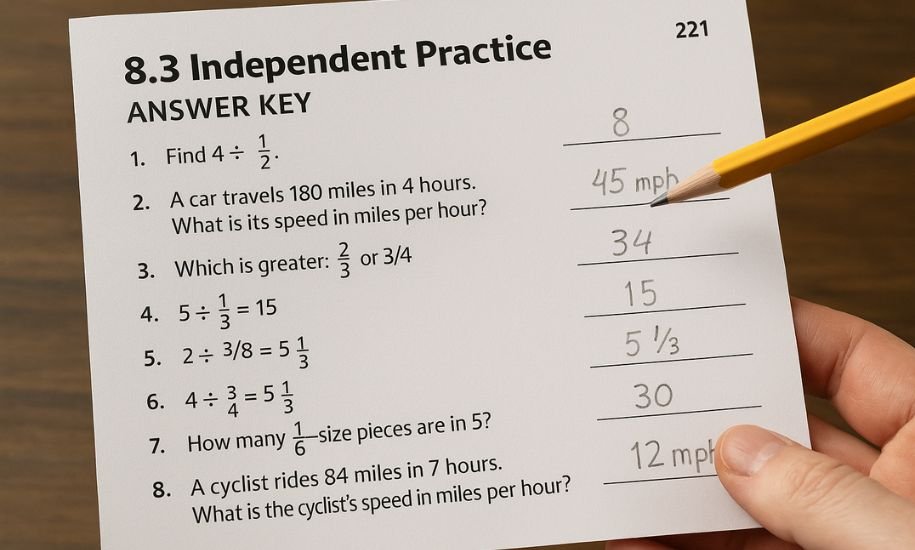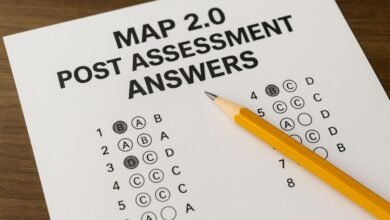8.3 Independent Practice Page 221 Answer Key – Go Math Lesson Guide

Mathematics is one of the most essential subjects in every learner’s academic journey, and mastering it requires both practice and understanding. Among the most widely used math textbooks in U.S. schools is the Go Math! series by Houghton Mifflin Harcourt. Each lesson in this program is carefully designed to build conceptual understanding through examples, guided instruction, and independent practice.
One topic that often generates curiosity from students and educators alike is “8.3 Independent Practice – Page 221 Answer Key.” This reference usually appears in Go Math Grade 5 or Grade 6 textbooks, depending on the edition. Parents and teachers frequently search for this topic using related keywords such as:
-
“8.3 Independent Practice Page 221 Answer Key PDF”
-
“8.3 Independent Practice Page 221 Answer Key Grade 6”
-
“8.3 Independent Practice Page 221 Answer Key Grade 5”
-
“Lesson 8.3 Answer Key”
-
“Go Math Grade 5 Chapter 8 Answer Key PDF”
-
“Go Math Grade 6 Chapter 8 Answer Key PDF”
-
“Practice and Homework Lesson 8.7 Answer Key”
-
“Go Math Grade 3 Chapter 8 Answer Key PDF”
This article explores the concepts typically covered in Lesson 8.3, offers guidance for solving similar problems, and explains how educators and students can responsibly use answer keys to strengthen mathematical understanding.
Understanding the Go Math! Curriculum
The Go Math! program is a standards-based mathematics curriculum that aligns with the Common Core State Standards (CCSS). It emphasizes problem-solving, reasoning, and conceptual understanding over rote memorization. Each chapter builds progressively, introducing students to new mathematical operations and real-life applications.
Typical Structure of a Lesson
Every lesson includes:
-
Essential Question: guiding idea connecting math to real life.
-
Model and Draw: conceptual explanation through visuals.
-
Guided Practice: problems worked out with teacher assistance.
-
Independent Practice: problems for students to solve individually.
-
Homework Practice: additional exercises for reinforcement.
Lesson 8.3, often appearing on page 221, represents a midpoint in Chapter 8, which commonly deals with fractions, decimals, or dividing fractions—depending on grade level.
What Lesson 8.3 Usually Covers
Grade 5: Fractions and Division
In Go Math Grade 5, Chapter 8 usually focuses on dividing fractions or multiplying fractions by whole numbers. Lesson 8.3 may carry a title like:
“Interpret Division of a Whole Number by a Unit Fraction.”
Students learn how to understand expressions such as 3÷143 \div \frac{1}{4} by thinking, “How many one-fourths are in 3?” This type of reasoning builds a bridge between arithmetic and algebraic thinking.
Grade 6: Ratios and Rates
In Go Math Grade 6, Chapter 8 often centers on ratios, rates, or percentages. Lesson 8.3 might be titled:
“Finding Unit Rates” or “Comparing Rates.”
Students work on problems like:
-
“A car travels 150 miles in 3 hours. What is the rate in miles per hour?”
-
“Which is the better buy: 3 pounds for $9 or 5 pounds for $15?”
These exercises develop proportional reasoning, critical for algebra and higher mathematics.
Grade 3: Introduction to Fractions
For younger learners, particularly in Go Math Grade 3 Chapter 8, the emphasis is on fraction basics—identifying parts of a whole, comparing fractions, and understanding numerators and denominators. Although the “8.3 Independent Practice Page 221” may not exactly exist in Grade 3 textbooks, the concept of Lesson 8.3 remains consistent: practicing fraction reasoning through visual models and number lines.
Why “Independent Practice” Matters
The “Independent Practice” section of every Go Math lesson is designed for self-assessment and skill mastery. Here, students apply what they’ve just learned without direct teacher guidance.
-
It strengthens problem-solving ability and logical reasoning.
-
It helps teachers assess individual comprehension.
-
It prepares students for quizzes, standardized tests, and real-world applications.
Thus, the page 221 Independent Practice 8.3 section represents a key checkpoint: it tests how well students can apply the lesson independently.
Understanding the Purpose of an “Answer Key”
An answer key is not merely a cheat sheet—it’s a learning resource. When used correctly, it:
-
Provides immediate feedback.
-
Encourages self-correction.
-
Helps students recognize mistakes and understand patterns.
-
Supports teachers and parents in grading or guided review.
However, students should first attempt each problem independently before checking the key. The learning lies in the process, not the final answer.
How to Solve Typical Lesson 8.3 Problems
Below are examples reflecting the types of problems often found on Lesson 8.3 Independent Practice pages. (These are illustrative, not from the copyrighted workbook.)
Example 1: Division of a Whole Number by a Unit Fraction (Grade 5)
Problem:
Find 4÷124 \div \frac{1}{2}.
Solution:
Dividing by a fraction is equivalent to multiplying by its reciprocal.
4÷12=4×2=8.4 \div \frac{1}{2} = 4 \times 2 = 8.
Explanation:
There are eight halves in four wholes.
Example 2: Finding a Unit Rate (Grade 6)
Problem:
A car travels 180 miles in 4 hours. What is its speed in miles per hour?
Solution:
Unit rate = total miles ÷ hours = 180÷4=45 mph.180 ÷ 4 = 45 \text{ mph.}
Example 3: Fraction Comparison (Grade 3)
Problem:
Which is greater: 23\frac{2}{3} or 34\frac{3}{4}?
Solution:
Find a common denominator: 12.
23=812\frac{2}{3} = \frac{8}{12}; 34=912\frac{3}{4} = \frac{9}{12}.
Therefore, 34\frac{3}{4} is greater.
By understanding the logic behind each step, learners can use answer keys to confirm understanding rather than replace problem-solving.
Responsible Use of “8.3 Independent Practice Answer Keys”
Many educational blogs and forums provide “answer keys” or “solution guides” in PDF form. While they can help with review, it’s important to use them ethically and educationally.
Tips for Responsible Use
-
Attempt problems first. Checking the key afterward reinforces memory.
-
Use keys for learning, not copying. Focus on the explanation, not just the result.
-
Discuss with teachers or parents. Clarify misunderstood steps.
-
Avoid unauthorized sharing. Textbook materials are copyrighted; only official resources or fair-use explanations should be used.
Websites claiming to offer “8.3 Independent Practice Page 221 Answer Key PDF Download” often violate copyright or provide inaccurate information. Always verify that your source is educational and legitimate.
Online Resources for Lesson 8.3 Help
If you’re studying Go Math Lesson 8.3 (Grade 5 or Grade 6), here are some ways to get quality assistance without relying on leaked answer keys.
1. Official HMH Go Math! Resources
-
Visit hmhco.com and navigate to Go Math! Student Resources.
-
Access interactive lessons, virtual manipulatives, and video tutorials.
2. Teacher Blogs and Educational Forums
Several teachers maintain educational blogs offering guided explanations (not full keys) for Go Math lessons. Searching terms such as “Go Math Lesson 8.3 Grade 5 examples” often yields step-by-step breakdowns of key concepts.
3. YouTube Channels and Video Lessons
Educational YouTubers often provide:
-
Visual explanations for dividing fractions or solving ratio problems.
-
“Lesson 8.3 Independent Practice” walkthroughs tailored to specific grades.
4. Math Practice Platforms
Websites like Khan Academy, IXL, or Edulastic provide interactive exercises aligned with the same standards as Go Math! Chapter 8 lessons.
Cross-Grade Comparison: Lessons 8.3 and 8.7
Students often look up both Lesson 8.3 and Lesson 8.7 Answer Keys together. Lesson 8.7 typically builds on the concepts introduced in 8.3.
| Grade | Lesson 8.3 Focus | Lesson 8.7 Focus | Skills Developed |
|---|---|---|---|
| Grade 3 | Identifying fractions | Comparing fractions | Visual fraction reasoning |
| Grade 5 | Dividing by unit fractions | Word problems with fractions | Fraction division fluency |
| Grade 6 | Finding unit rates | Percent and ratio word problems | Proportional reasoning |
Recognizing this progression helps students see how early lessons prepare them for more complex operations later.
Practical Tips for Students
-
Create a Math Journal: Write step-by-step reasoning for each Independent Practice problem.
-
Review Common Mistakes: Go Math! lessons often include “Check Your Work” boxes—use them.
-
Study With Peers: Group study sessions can clarify tricky problems like dividing by fractions.
-
Relate to Real Life: Connect ratios or fractions to cooking, travel, or sports to make learning tangible.
Practical Tips for Parents and Educators
-
Guide Without Giving Answers: Ask leading questions such as “What is the problem asking you to find?”
-
Encourage Reflection: Have students explain why an answer makes sense.
-
Leverage Online Tools: Use official Go Math! portals or reputable learning apps to simulate classroom exercises.
-
Maintain Consistency: Reinforce daily practice—math mastery comes through repetition and confidence.
Understanding “Go Math Answer Key PDFs”
Many educators compile unofficial “Go Math Answer Key PDFs” for quick reference. These documents summarize solutions for all chapters, including:
-
Go Math Grade 5 Chapter 8 Answer Key PDF
-
Go Math Grade 6 Chapter 8 Answer Key PDF
-
Go Math Grade 3 Chapter 8 Answer Key PDF
If you encounter these PDFs online, ensure they are authorized reproductions or teacher-created summaries under fair use. When legitimate, they can serve as valuable study aids and time-savers during revision.
Integrating Technology in Math Learning
Modern classrooms are embracing digital learning to enhance comprehension. Go Math! integrates with:
-
HMH Player App: offers interactive lesson practice.
-
Google Classroom: enables assignment submission and feedback.
-
SmartBoard Tools: for modeling fraction division or ratio comparisons visually.
Digital platforms often include automatic grading and hints, effectively replacing the need for separate answer-key documents.
Why Chapter 8 Is Crucial Across Grades
Chapter 8 is pivotal in all Go Math! grade levels:
-
In Grade 3, it introduces fraction concepts.
-
In Grade 5, it expands to operations with fractions.
-
In Grade 6, it transitions to ratios, rates, and proportional relationships.
Thus, mastering Lesson 8.3 at each level establishes a foundation for algebra and geometry in higher grades.
Conclusion – Building Confidence Through Practice
The search for the “8.3 Independent Practice Page 221 Answer Key” reflects a common desire among students and parents: finding ways to learn faster and verify accuracy. However, the real key to success lies in understanding the process—not merely obtaining the answers.
Whether you’re exploring Go Math Grade 5 Chapter 8 or Grade 6 Lesson 8.3, take time to practice, analyze, and discuss each problem. Independent practice strengthens critical thinking and problem-solving abilities that extend far beyond mathematics.
For more educational insights, study guides, and step-by-step math help, visit our blog American Times—where learning meets curiosity.
